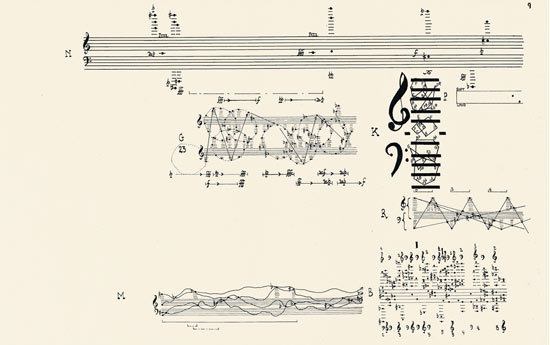John Cage and Ray Johnson
Museu d’Art Contemporani de Barcelona (MACBA)
Plaça dels Àngels, 1
08001 Barcelona
MACBA forthcoming exhibitions:
A major retrospective of the works, thoughts and influences of John Cage, as well as an extensive presentation of the work of Ray Johnson, are two major features of the autumn programme at the Museum of Contemporary Art in Barcelona (MACBA). Cage and Johnson, both American artists, knew each other during their lifetimes. Although independently curated, the decision to show the two exhibitions in the Museum at the same time highlights the fact that both artists were concerned with inventing a language that addressed the ascendency of the contemporary versus the modern. They shared a common attempt to reconfigure the epistemological foundation of the modern project, that is, the ways in which we know what constitutes culture and what does not. Language cannot be reflected in the transparency of signs, therefore through their work we are forced to invent, to create new methods to recall the world.
THE ANARCHY OF SILENCE. JOHN CAGE AND EXPERIMENTAL ART
Museu d’Art Contemporani de Barcelona (MACBA), 23 October 2009 – 10 January 2010
Curator: Julia Robinson
Exhibition organized by Museu d’Art Contemporani de Barcelona and coproduced with Henie Onstad Art Centre, Høvikodden (Norway)
John Cage (1912–1992) defined a radical practice of ‘experimental’ composition that not only changed the course of modern music and dance, but also defined a new conceptual horizon for artistic practice in the late-twentieth century. Illuminating the relevance of Cage’s contribution to contemporary art, the MACBA presents the most extensive exhibition devoted to the artist since his death, and the first to focus on the historicisation of the composer’s oeuvre and its impact.
The exhibition systematically traces the critical developments in Cage’s career: from his work with percussion (1930s), to the prepared piano (1940s), to chance and indeterminacy (1950s), to new media (1960s onward), through to the political focus that increasingly and explicitly informed the work in the last decades of his life. Cage ushered in formal, structural, temporal and media innovations that now form cornerstones of contemporary consciousness. In this show, his changing approaches materialise as the powerful series of conceptual catalysts through which the composer altered the terms of creative practice at large. Sound-recordings, films, scores, and documentary materials provide an insight into the extraordinary scope of Cage’s project. Through a chronological treatment of the scores and their realisations – from unorthodox percussion instruments, or ‘noisemakers’, to the sounds of the environment, and from grand staff (musical) notation to mere textual instructions – Cage’s breaks and innovations are juxtaposed with the art generated in his midst, revealing the many conceptual openings he created.
Because of its special position in exploring the work of a composer from the perspective of a museum of contemporary art, the exhibition considers Cage’s encounters with artists as a key part of the historicisation of his practice. As artists were rejecting expression, Cage developed indeterminate composition, and his scores became a crucial model for mediating the creative act. When Marcel Duchamp announced that ‘the spectator completes the work’ (1957), Cage’s concept of the indeterminate score arrived as a matrix to test this idea. His work recalibrated the relationship between score and performance, author and receiver. This was the conceptual ground taken up by artists. Thus, artists of all types loom large in this account of Cage – from Duchamp and Calder, to Rauschenberg and Ellsworth Kelly, and from Henry Flynt to Warhol, Paik and Fluxus. Revealing a new conceptual field that reconfigures our sense of postwar artistic practice, the landmarks of Cage’s oeuvre are positioned in relation to key works by contemporaries. We witness unexpected synergies between Cage and the artists who shared his commitments to the new, the non-subjective and the changing, to mediated models of ‘composition’ and to an embrace of the technology that redefined art’s engagement of perceptual experience.
RAY JOHNSON: PLEASE ADD TO & RETURN
Museu d’Art Contemporani de Barcelona (MACBA), 5 November 2009 – 10 January 2010
Curator: Alex Sainsbury in collaboration with Chus Martínez
This exhibition proposes an interpretation of the different forms of dialogue with the material of the work, with the art world and the possibility of creating an anonymous circuit of distribution and feedback in the work of the American artist Ray Johnson (1927–1995). As little-known as he is fascinating, Johnson is a key element for the understanding of an epoch and a way of approaching the relationship of the artist with the artistic community of New York, the city where he created his work for more than forty years.
Johnson’s work investigated the complex communicative processes that arise when an image is altered, and explored how these generate bureaucratic systems within culture. He created a new economy of messages in the whole body of his work, a very personal and ambitious form of concrete poetry. Even before the Pop art movement, Johnson’s work evidenced a fascinating anthropological dimension that dealt with his perception of the society of distribution and consumption, as well as shrewd references of the question of sexual orientation in the culture of that time.
His collages, drawings and multiple forms of mail art were conceived as inserts, commentaries in which his personal imagination, popular culture and his view of the art world were combined to give body to a complex network of meanings. The supports he used and the way he manipulated them, stubbornly and constantly, created the sensation that whoever took part was an outsider, somebody who did not belong to the artistic community, who could not be called a ‘professional’ artist, but was an amateur. Johnson mimicked himself and mimicked his work with the hand of one who looks in from the outside, but observes with curiosity what happens ‘within’ the circle.
Further information www.macba.cat

